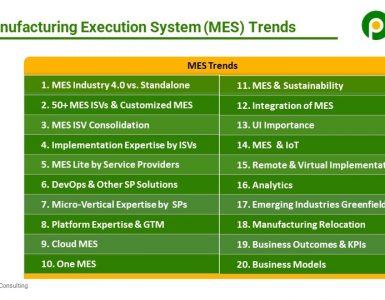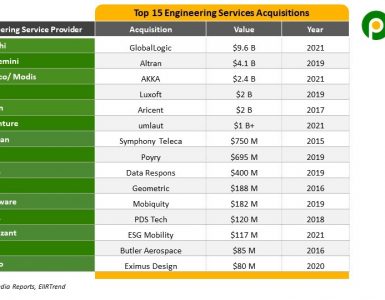The performance of Indian engineering service providers in 2023 was truly remarkable, with the majority of them achieving double-digit growth. Notably, these providers have consistently delivered impressive results over the past three years. In contrast, the year 2023 stood out as a special one, as the robust performance of engineering services contrasted with the relatively subdued results seen in the IT services sector.
Looking ahead to 2024, the question arises: will engineering service providers maintain their growth momentum? What factors will fuel the growth of engineering services in the coming year?

There are eight major growth drivers for engineering services in 2024.
Tailwind: Automotive & Aerospace
Two biggest tailwinds in engineering services are automotive and aerospace engineering
- Automotive is the biggest tailwind in engineering services. Auto enterprises are awarding large deals to engineering service providers, and the pace of large deals has increased in the last couple of years. (Read here)
- Aerospace is another significant tailwind. During the COVID pandemic, it was the most affected sector within engineering services. The decline in commercial travel adversely impacted airlines, aerospace OEMs/suppliers, and their product and engineering strategies. However, aerospace engineering has since made a robust recovery. (Read here)
Large Cost Take Out Deals:
- Enterprises are looking to reduce costs of their engineering operations. Recent examples of large cost-take out deals are across industries including Media, ISV, Hi-tech, Healthcare, BFSI, Edtech, etc. (Read here)
- Different deal archetypes including captive buyout, variable cost structure, vendor consolidation, product carveout, product sustenance, enterprise solution monetization, professional services carveout, etc.
- One good example of a large deal with many deal archetypes is Infosys – Liberty Global deal. (Read here).
Delivery More Offshoring:
- Many enterprises are now more inclined to offshore their engineering services to India as opposed to other locations. Traditionally, engineering has been seen as core work for enterprises, accompanied by the belief that it couldn't be outsourced, and if it could, it couldn't be offshored on a large scale. This perspective gave European service providers an advantage due to their onshore presence. However, the pandemic prompted enterprises to reassess these beliefs. With much of the work being done virtually then, location isn't as significant a barrier as it once was. This shift in perspective is leading enterprises to reevaluate their engineering operating models, and India stands out as an optimal choice given its ability to offer engineering talent at scale and competitive price points. This trend towards offshoring is highlighted by the fact that while many global and regional engineering service providers experienced negative quarter-over-quarter growth last quarter, most Indian providers saw positive growth. (Read here).
M&A Capability & Access:
- Indian engineering service providers are becoming more assertive and ambitious in their inorganic growth strategies. They are acquiring other engineering services companies to broaden their capabilities and customer access. This augmentation through acquisition focuses on three main areas: industry, services, and geography. (Read here)
Localization: R&D Follows Manufacturing
- A localization push is gaining momentum across various industries and regions, driven by factors like geopolitics, supply chain disruptions, and government agendas. This trend is notably evident in the manufacturing sector, exemplified by the "China plus" strategy. Its effects ripple through industries such as semiconductors, electronics, defense, and automotive. As a result of this shift, we are witnessing increased manufacturing investments in diverse regions, including India, the Middle East, Europe, Latin America, and Southeast Asia, among others.
- This shift in manufacturing has a direct impact on R&D and engineering services, as R&D tends to follow manufacturing activities. Already, we are observing a surge in semiconductor R&D initiatives in Europe and India, as well as heightened automotive development in the Middle East and North Africa (MENA) region. (Read here)
Technology: Generative AI
- GenAI is poised to exert its influence on the engineering services market in two distinct ways:
- Engineering GenAI: This category encompasses the application of GenAI in various engineering functions, including product design, product engineering, manufacturing, and operations. It follows a unique developmental trajectory, with significant investments from major engineering service providers. Most enterprises are actively engaged in Proof of Concepts (PoCs) in this area, with the potential for substantial scaling in 2024 and beyond.
- GenAI Engineering: This aspect involves the integration of GenAI across a wide range of industries and services, offering a broader scope. It holds particular significance for digital engineering service providers and has the potential to serve as the catalyst for the next surge in the growth of software engineering services, akin to the rise of cloud services a few years ago. (Read here).
Digitalization: Digital in Physical
- In physical or asset-intensive industries, the concept of "digital" manifests in both product and process domains.
- In the automotive sector, the digital aspect within products includes electric vehicles (EVs) and software driven vehicles (SDVs), whereas digitalization in processes involves activities like digital sales and digital manufacturing. In other industries, digitalizing processes might encompass digital commerce, digitalized stores, digital healthcare facilities, and digital utilities.
- Currently the focus of most engineering service providers is more on digitalizing products. However, there is a growing trend among engineering service providers to now also target the digitalization of processes.
Consulting: Engineering Process
- The next phase of engineering growth is likely to be fueled by consulting efforts aimed at solving complex business challenges and reimagining products, services, processes, and business models in the era of Generative AI (Gen AI).
- Consulting-Driven Solutions for Business Challenges: As enterprises seek to enhance their competitiveness through the strategic utilization of emerging technologies, engineering and R&D must align closely with their overall strategies, processes, business models, operations, and technology stack. An emerging opportunity for engineering service providers lies in addressing these business challenges, such as boosting sales, reducing operational costs, minimizing working capital, optimizing inventory management, averting financial crises, ensuring seamless supply chain operations, increasing product or service utilization, enhancing customer experiences, and implementing virtualization, among others, through the application of engineering expertise. These opportunities are consultancy-driven, yielding downstream engineering revenues.
- Process Transformation in the Gen AI Era: If Generative AI becomes pervasive within enterprises, they will require substantial support in integrating Generative AI into their products, services, processes, and business models. This entails identifying business challenges and leveraging Generative AI to address them effectively. This transformative journey also involves exploring new possibilities – identifying novel capabilities that can be developed in products, services, processes, or business models by harnessing Generative AI to enhance business performance. While conducting pilot projects and proofs of concept is a crucial step, organizations aiming to fully harness the benefits of Generative AI at scale must evolve their products, services, processes, and business models. This necessitates a blend of business consulting, process consulting, subject matter expertise, research and development (R&D) or engineering prowess, and technology architecture to guide and assist enterprises in this endeavor. (Read here).
Several trends from previous years, including sustainability, the metaverse, and 5G, saw a slowdown in 2023. However, it's important to note that when the macroeconomic situation and investment climate improve, these trends may regain momentum and accelerate again.
Bottomline: There's much discussion about whether engineering services have reached an inflection point, and if the pandemic has acted as an accelerator for engineering service outsourcing, similar to how the 2008 Global Financial Crisis boosted IT outsourcing. The performance over the past three years offers promise, and if engineering service providers can continue to leverage these growth drivers, we can foresee a robust pattern of double-digit growth persisting for the fourth consecutive year in 2024






 Pareekh Jain
Founder of Pareekh Consulting & EIIRTrends
Pareekh Jain
Founder of Pareekh Consulting & EIIRTrends
Add comment